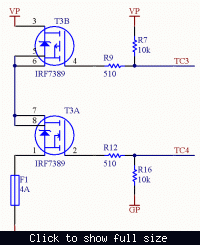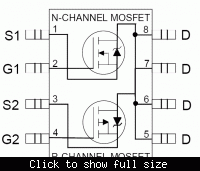RoboColor
Junior Member level 1
- Joined
- Jun 30, 2007
- Messages
- 16
- Helped
- 0
- Reputation
- 0
- Reaction score
- 0
- Trophy points
- 1,281
- Location
- Beijing China
- Activity points
- 1,390
Dear All,
I met a very serious problem in my project. I use IRF7389 to form a simple circuit as the following:

The structure of IRF7389 is as the following:

In one case, I put TC3 in a stable level equal to Vp. When I add pulse(5V 250Hz) on TC4, problem occurs. The current in F1(a fuse) increases greatly at this time and it seems like the two MOSFETs turn on at the same time.
I do not know where is wrong. Please help me! Thanks a lot!
I met a very serious problem in my project. I use IRF7389 to form a simple circuit as the following:

The structure of IRF7389 is as the following:

In one case, I put TC3 in a stable level equal to Vp. When I add pulse(5V 250Hz) on TC4, problem occurs. The current in F1(a fuse) increases greatly at this time and it seems like the two MOSFETs turn on at the same time.
I do not know where is wrong. Please help me! Thanks a lot!